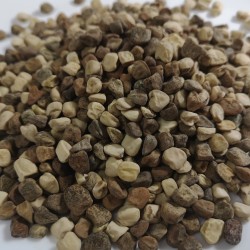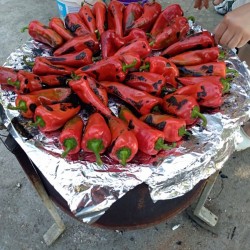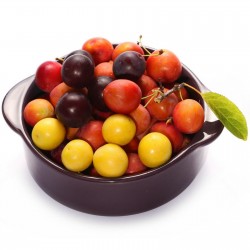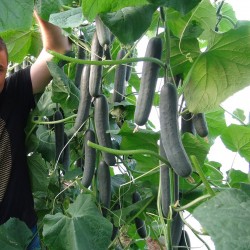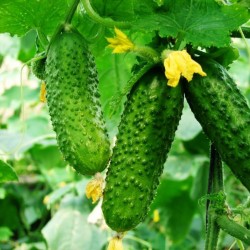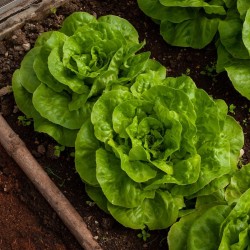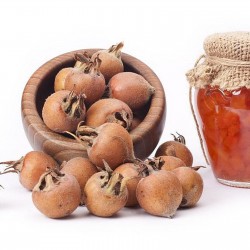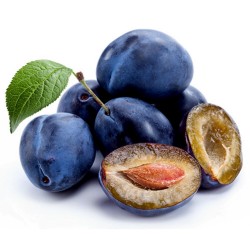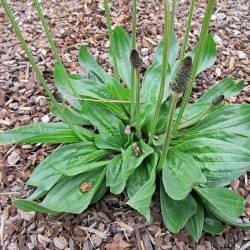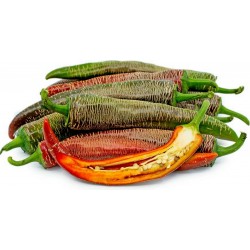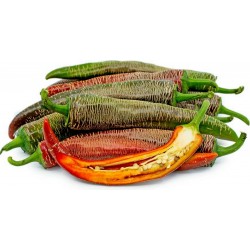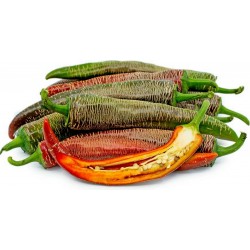Seeds Gallery Com,
5/
5
<h2><strong>Mispel zaden (Mespilus germanica)</strong></h2>
<h2><span style="color: #ff0000;"><strong>Prijs voor Pakket van 10 zaden.</strong></span></h2>
<p style="color: #202122; font-size: 14px;">De<span> </span><b>mispel</b><span> </span>(<i>Mespilus germanica</i>), ook wel "wilde mispel" <sup id="cite_ref-1" class="reference"></sup>is een<span> </span>heester<span> </span>uit de<span> </span>rozenfamilie<span> </span>(<i>Rosaceae</i>). <sup id="cite_ref-2" class="reference"></sup>Ook de<span> </span>vrucht<span> </span>wordt mispel genoemd. De mispel is een<span> </span>archeofyt, een<span> </span>ingeburgerde<span> </span>plant, die omstreeks de zevende eeuw voor Christus in Europa is ingevoerd.</p>
<h2 style="color: #000000; font-size: 1.5em;"><span class="mw-headline" id="Beschrijving">Beschrijving</span></h2>
<p style="color: #202122; font-size: 14px;">De mispel is een struik tot kleine boom<sup id="cite_ref-3" class="reference">[3]</sup><span> </span>met een hoogte van 1,5 tot 6 meter, die aan een appelboom doet denken. Het hout is hard, taai en fijnnervig,<sup id="cite_ref-Ensie_4-0" class="reference">[4]</sup><sup id="cite_ref-RvdK_5-0" class="reference">[5]</sup><span> </span>met gedoornde en dikviltige twijgen. De takken zijn spreekwoordelijk kronkelig<sup id="cite_ref-RvdK_5-1" class="reference">[5]</sup><span> </span>en de plant is vaak breder dan hoog.</p>
<p style="color: #202122; font-size: 14px;">De bladeren zijn 5 tot 12 cm groot, langwerpig, omgekeerd-eirond en aan beide zijden zacht behaard en worden in de winter afgeworpen. De<span> </span>bladvorm<span> </span>is gaafrandig of bovenaan fijn gezaagd en toegespitst. Ze zijn donkergroen. en hebben een zeer korte steel.</p>
<p style="color: #202122; font-size: 14px;">De mispel bloeit in mei met witte, soms iets roze bloemen, die lijken op die van een<span> </span>wilde roos. De bloemen zijn<span> </span>tweeslachtig, alleenstaand, 2½ tot 4 cm groot, en hebben 40<span> </span>meeldraden. De bloemstelen en kelk zijn zacht behaard.</p>
<p style="color: #202122; font-size: 14px;">De bruine pitvruchten hebben grote kelkslippen, zijn<span> </span>tweezaadlobbig<span> </span>en hebben een diameter van 2 tot 3½ cm.</p>
<h2 style="color: #000000; font-size: 1.5em;"><span class="mw-headline" id="Taxonomie">Taxonomie</span></h2>
<p style="color: #202122; font-size: 14px;">De mispel wordt ingedeeld bij het<span> </span>monotypische<span> </span>geslacht<span> </span><i>Mespilus</i>. In 1990 werd een Amerikaanse soort beschreven onder de naam<span> </span><i>Mespilus canescens</i>, maar dit bleek een<span> </span>triploïde<span> </span>hybride<span> </span>met de<span> </span>meidoorn<span> </span>te zijn, aangeduid als<span> </span>×Crataemespilus.<sup id="cite_ref-6" class="reference">[6]</sup><span> </span>Verwant aan de mispel zijn planten uit de<span> </span>rozenfamilie<span> </span>(<i>Rosaceae</i>), waaronder de<span> </span>Japanse mispel, de<span> </span>appel<span> </span>en de<span> </span>peer.</p>
<h3 style="color: #000000; font-size: 1.2em;"><span class="mw-headline" id="Cultivars">Cultivars</span></h3>
<p style="color: #202122; font-size: 14px;">Gekweekte mispels hebben over het algemeen grotere bladeren en vruchten en hebben vaak geen doorns.</p>
<p style="color: #202122; font-size: 14px;">Cultivars<span> </span>van de mispel (<i>Mespilus germanica</i>) zijn onder andere:</p>
<ul style="color: #202122; font-size: 14px;">
<li>'Macrocarpa', de grootvruchtige mispel, met vruchten tot 6½ cm. in doorsnede. In cultuur sinds ongeveer 1630.<sup id="cite_ref-7" class="reference">[7]</sup></li>
<li>'Bredase Reus', geeft grote ruwe, dofbruine vruchten.<sup id="cite_ref-nltuin_8-0" class="reference">[8]</sup></li>
<li>'Hollandse Mispel', heeft grote bloemen en geeft bruine vruchten.<sup id="cite_ref-nltuin_8-1" class="reference">[8]</sup></li>
<li>'Nottingham', klein blijvende struik, geeft kleine bruine vruchten.<sup id="cite_ref-nltuin_8-2" class="reference">[8]</sup></li>
<li>'Westerveld', rijkdragend, middelgrote bruine vruchten.<sup id="cite_ref-nltuin_8-3" class="reference">[8]</sup></li>
</ul>
<p style="color: #202122; font-size: 14px;">Hybriden van de<span> </span>tweestijlige meidoorn<span> </span>en de mispel worden sinds de middeleeuwen gekweekt en dragen de naam<span> </span><i>×Crataemespilus grandiflora</i>. Ook wordt de mispel wel<span> </span>geënt<span> </span>op een onderstam van de tweestijlige meidoorn.</p>
<div class="thumb tright" style="color: #202122; font-size: 14px;">
<div class="thumbinner" style="font-size: 13.16px;"><img alt="" src="https://upload.wikimedia.org/wikipedia/commons/thumb/8/85/109_Mespilus_germanica_L.jpg/260px-109_Mespilus_germanica_L.jpg" decoding="async" width="260" height="363" class="thumbimage" srcset="//upload.wikimedia.org/wikipedia/commons/thumb/8/85/109_Mespilus_germanica_L.jpg/390px-109_Mespilus_germanica_L.jpg 1.5x, //upload.wikimedia.org/wikipedia/commons/thumb/8/85/109_Mespilus_germanica_L.jpg/520px-109_Mespilus_germanica_L.jpg 2x" data-file-width="600" data-file-height="837">
<div class="thumbcaption" style="font-size: 12.3704px;">
<div class="magnify"></div>
Mispel in<span> </span><i>Atlas des plantes de France</i><span> </span>(1891)</div>
</div>
</div>
<h2 style="color: #000000; font-size: 1.5em;"><span class="mw-headline" id="Voorkomen">Voorkomen</span></h2>
<p style="color: #202122; font-size: 14px;">Het oorsprongsgebied van de mispel ligt rond de<span> </span>Zwarte<span> </span>en de<span> </span>Kaspische Zee; Zuidoost-Bulgarije is de westgrens.</p>
<p style="color: #202122; font-size: 14px;">Drieduizend jaar geleden werd de mispel al in de omgeving van de<span> </span>Kaspische Zee<span> </span>(Noord-Iran) aangeplant. De vrucht kwam rond 700 v.Chr. naar<span> </span>Griekenland<span> </span>en rond 200 v.Chr. naar Rome. De mispel is door de Romeinen verder verspreid. Het was een zeer belangrijke vrucht tijdens het<span> </span>Romeinse Keizerrijk<span> </span>en de<span> </span>Middeleeuwen<span> </span>nog voor de introductie van andere fruitsoorten in West-Europa. Ze werd in de Middeleeuwen vooral in Frankrijk en Duitsland aangeplant en in de<span> </span>Nederlanden<span> </span>in<span> </span>kloostertuinen. De vrucht is veel minder algemeen dan vroeger, maar wint weer iets aan populariteit.</p>
<p style="color: #202122; font-size: 14px;">Nederland en België liggen aan de rand van het<span> </span>verspreidingsgebied. In Nederland is de struik zeldzaam in<span> </span>Twente, in de<span> </span>Achterhoek, het oostelijk rivierengebied en in<span> </span>Zuid-Limburg. Elders is ze zeer zeldzaam. Voor de verspreiding in Vlaanderen geldt dat de soort vrij zeldzaam is in de<span> </span>Leemstreek<span> </span>en de<span> </span>Voerstreek<span> </span>en elders zeldzaam. In Wallonië komt de mispel vrij zeldzaam voor in het<span> </span>Maasgebied<span> </span>en in<span> </span>Brabant, elders is ze veel zeldzamer.</p>
<h2 style="color: #000000; font-size: 1.5em;"><span class="mw-headline" id="Ecologie">Ecologie</span></h2>
<p style="color: #202122; font-size: 14px;">De mispel is een<span> </span>kensoort<span> </span>voor het<span> </span>veldbies-beukenbos<span> </span>(<i>Luzulo luzuloides-Fagetum</i>). De plant benodigt een zonnige tot licht beschaduwde, warme plaats op vochtige, matig voedselrijke, kalkarme, zwak zure tot neutrale grond (leem, lemig zand, löss en rivier- of beekzand). Groeiplaatsen bestaan uit<span> </span>struweel<span> </span>in lichte loofbossen en beekoeverwalbossen, bosranden, houtwallen, heggen, oude boomgaarden en langs holle wegen.</p>
<h2 style="color: #000000; font-size: 1.5em;"><span class="mw-headline" id="Gebruik_en_voedingswaarde">Gebruik en voedingswaarde</span></h2>
<div class="thumb tright" style="color: #202122; font-size: 14px;">
<div class="thumbinner" style="font-size: 13.16px;"><img alt="" src="https://upload.wikimedia.org/wikipedia/commons/thumb/f/f0/Mispelstruik_zonder_blad.jpg/260px-Mispelstruik_zonder_blad.jpg" decoding="async" width="260" height="150" class="thumbimage" srcset="//upload.wikimedia.org/wikipedia/commons/thumb/f/f0/Mispelstruik_zonder_blad.jpg/390px-Mispelstruik_zonder_blad.jpg 1.5x, //upload.wikimedia.org/wikipedia/commons/thumb/f/f0/Mispelstruik_zonder_blad.jpg/520px-Mispelstruik_zonder_blad.jpg 2x" data-file-width="3225" data-file-height="1865">
<div class="thumbcaption" style="font-size: 12.3704px;">
<div class="magnify"></div>
Mispels in de late herfst</div>
</div>
</div>
<h3 style="color: #000000; font-size: 1.2em;"><span class="mw-headline" id="Vruchten">Vruchten</span><span class="mw-editsection" style="font-size: small;"><span class="mw-editsection-bracket" style="color: #54595d;">[</span>bewerken<span class="mw-editsection-divider" style="color: #54595d;"><span> </span>|<span> </span></span>brontekst bewerken<span class="mw-editsection-bracket" style="color: #54595d;">]</span></span></h3>
<div class="thumb tright" style="color: #202122; font-size: 14px;">
<div class="thumbinner" style="font-size: 13.16px;"><img alt="" src="https://upload.wikimedia.org/wikipedia/commons/thumb/3/34/Mispel-vrucht.jpg/260px-Mispel-vrucht.jpg" decoding="async" width="260" height="195" class="thumbimage" srcset="//upload.wikimedia.org/wikipedia/commons/thumb/3/34/Mispel-vrucht.jpg/390px-Mispel-vrucht.jpg 1.5x, //upload.wikimedia.org/wikipedia/commons/3/34/Mispel-vrucht.jpg 2x" data-file-width="506" data-file-height="380">
<div class="thumbcaption" style="font-size: 12.3704px;">
<div class="magnify"></div>
Eetrijpe mispels</div>
</div>
</div>
<p style="color: #202122; font-size: 14px;">De mispel zit vol<span> </span>vitamine C<span> </span>en is goed voor de maag en voor de spijsvertering.<sup class="noprint nopopups"><span title="Voor deze uitspraak is sinds 25 juni 2019 een bronvermelding gewenst. Motivering: Gezondheidsclaims hebben altijd bronvermelding nodig">[bron?]</span></sup></p>
<p style="color: #202122; font-size: 14px;">Er worden droge, kleine, harde, goudbruine<span> </span>vruchten<span> </span>gevormd, die in oktober rijp, maar dan nog ongenietbaar melig en wrang zijn. Na de eerste<span> </span>nachtvorsten<span> </span>worden ze zacht en bruin en dan kunnen ze na een poosje wel gegeten worden. Aanbevolen wordt<sup class="noprint nopopups"><span title="Voor deze uitspraak is sinds 09 juni 2021 een bronvermelding gewenst. Motivering: Door wie?">[bron?]</span></sup><span> </span>om ze in oktober of november na een nachtvorst te plukken en ze met de bovenkant naar onderen twee tot drie weken te bewaren op een koele plaats. Dit bewaren wordt<span> </span><i>bletten</i><span> </span>genoemd. De vrucht wordt 'beurs', waarbij de kleur door een<span> </span>fermentatieproces<span> </span>verandert van groen/wit naar donkerbruin en de smaak zoet weeïg wordt. Ook is het mogelijk de vruchten enkele dagen in de<span> </span>diepvriezer<span> </span>te leggen, wat een iets andere smaak geeft dan het bletten. Het<span> </span>vruchtvlees<span> </span>is dan zo zacht, dat het uit de schil gezogen kan worden. Voor sommigen is de mispel een lekkernij. Het gezegde: "Zo rot als een mispel" slaat dus in feite op een lekkernij. Als de mispel zacht is, is hij maar een paar dagen houdbaar, omdat hij dan gemakkelijk kan gaan<span> </span>beschimmelen<span> </span>en echt gaan rotten.</p>
<p style="color: #202122; font-size: 14px;">Als de mispels zacht zijn kan er gelei en likeur van gemaakt worden.</p>
<p style="color: #202122; font-size: 14px;">In Nederland zijn mispels af en toe te koop bij de supermarkt, op markten en bij groentespeciaalzaken. De<span> </span>loquat<span> </span>(<i>Eriobotrya japonica</i>) of Japanse mispel is een verwante soort die ook wel als<span> </span><i>mispel</i><span> </span>wordt verkocht.</p>
<p style="color: #202122; font-size: 14px;">100 gram verse mispel bevat:</p>
<table class="wikitable" style="color: #202122; font-size: 14px;">
<tbody>
<tr>
<td>Energetische waarde</td>
<td>398<span> </span>kJ<span> </span>(95<span> </span>Kcal)</td>
</tr>
<tr>
<td>Koolhydraten</td>
<td>21,3 gram</td>
</tr>
<tr>
<td>Eiwit</td>
<td>0,8 gram</td>
</tr>
</tbody>
</table>
<h3 style="color: #000000; font-size: 1.2em;"><span class="mw-headline" id="Hout">Hout</span></h3>
<p style="color: #202122; font-size: 14px;">Mispelhout is hard, taai en fijnnervig en werd in de<span> </span>late middeleeuwen<span> </span>gebruikt voor<span> </span>kammen<span> </span>en<span> </span>waterraderen.<sup id="cite_ref-Ensie_4-1" class="reference">[4]</sup></p>
<h2 style="color: #000000; font-size: 1.5em;"><span class="mw-headline" id="Mispel_in_taal_en_cultuur">Mispel in taal en cultuur</span></h2>
<h3 style="color: #000000; font-size: 1.2em;"><span class="mw-headline" id="Etymologie">Etymologie</span></h3>
<p style="color: #202122; font-size: 14px;">De<span> </span>geslachtsnaam<span> </span><i>Mespilus</i><span> </span>wordt wel uitgelegd als afkomstig van het Griekse<span> </span><i>mesos</i><span> </span>(midden) en<span> </span><i>spilos</i><span> </span>(klip of steenmassa), omdat de vijf pitten steenachtig zijn en met hun toppen uit het vruchtvlees steken.<sup id="cite_ref-nltuin_8-4" class="reference">[8]</sup><span> </span>Dit is echter onwaarschijnlijk, omdat de<span> </span>etymologie<span> </span>teruggaat op een onbekende, voor-Griekse taal. Via het<span> </span>Grieks<span> </span>en de<span> </span>Latijnse<span> </span>vorm<span> </span><i>mespila</i><span> </span>verspreidde het woord zich al in de<span> </span>vroeg-Romeinse tijd<span> </span>over Europa. De vorm<span> </span><i>mispel</i><span> </span>is hieruit ontstaan. Als aanduiding voor de vrucht is het woord in het Nederlands in 1240 geattesteerd, maar als aanduiding voor de bomen pas een kwart millennium later, circa 1480–1500. Zowel<span> </span><i>mispels</i><span> </span>als<span> </span><i>mispelen</i><span> </span>werd gebruikt als meervoud.<sup id="cite_ref-9" class="reference">[9]</sup></p>
<p style="color: #202122; font-size: 14px;">De soortnaam<span> </span><i>Germanica</i><span> </span>betekent "Duits". Verwilderde mispels kwamen in Duitsland veel voor in de bossen, waardoor men vroeger meende dat de boom daar<span> </span>inheems<span> </span>was.</p>
<h3 style="color: #000000; font-size: 1.2em;"><span class="mw-headline" id="Vrucht">Vrucht</span></h3>
<p style="color: #202122; font-size: 14px;">De mispel wordt vaak aangehaald in de uitspraak: 'zo rot als een mispel'. Vaak wordt deze uitspraak gecombineerd met een of meer personen en ook niet zelden met de gehele mensheid; dit om te duiden op de (mis)daden en het soms grillige karakter van de mens. Het onaantrekkelijke uiterlijk en de bruine kleur geven aanleiding tot<span> </span>scabreuze<span> </span>toespelingen: in het Frans wordt de mispel<span> </span><i>cul de chien</i><span> </span>(gat van de hond) genoemd en in het Engels<span> </span><i>openarse</i><span> </span>(open aars).<sup id="cite_ref-RvdK_5-2" class="reference">[5]</sup></p>
<h3 style="color: #000000; font-size: 1.2em;"><span class="mw-headline" id="Bloesem">Bloesem</span></h3>
<p style="color: #202122; font-size: 14px;">Mispelbloesem wordt in tegenstelling tot de vrucht wel gewaardeerd om zijn uiterlijk. In een oude uitvoering van het wapen van het<span> </span>Graafschap Gelre<span> </span>komen zogenaamde<span> </span>vijfbladen<span> </span>voor, uitgevoerd in rood. De<span> </span>Wichardsage, een<span> </span>ontstaansmythe<span> </span>van Gelre, interpreteert deze als mispelbloemen. In de oudst bekende versie van deze sage, uit<span> </span>1465, worden ze al genoemd, maar pas ruim een eeuw later wordt er een verklaring toegevoegd: mispels markeerden de plaats waar de draak verslagen was. De oude benaming<span> </span><i>Gelderse roos</i><span> </span>kan ontleend zijn aan de bloemen in het wapen van Gelre, maar kan ook verwijzen naar het feit dat Gelre min of meer de uiterste rand van het verspreidingsgebied vormde.<sup id="cite_ref-RvdK_5-3" class="reference">[5]</sup></p>
<p style="color: #202122; font-size: 14px;">Het vijfblad, soms uitdrukkelijk gespecificeerd als mispelbloem, komt ook voor in ettelijke<span> </span>dorps- en stadswapens<span> </span>en<span> </span>stadsvlaggen<span> </span>uit de invloedssfeer van Gelre.</p>
<p style="color: #202122; font-size: 14px;">Enkele voorbeelden van vijfbladen en mispels:</p>
<ul style="color: #202122; font-size: 14px;">
<li>het<span> </span>wapen van het Brabantse dorp Beek en Donk: vier bloemen.</li>
<li>het<span> </span>wapen van Doetinchem, een gemeente in Gelderland: drie bloemen.</li>
<li>het<span> </span>wapen van Gelderen<span> </span>(Geldern), een plaats in Duitsland, de voormalige hoofdstad van Gelre: drie bloemen.</li>
<li>het<span> </span>wapen van Goor, een stad in Twente. Het blazoen luidt onder meer: 'Van rood beladen met een kruis van zilver en gekantonneerd van een mispelbloem van zilver, gepunt van groen.'</li>
<li>de<span> </span>vlag van de Gelderse gemeente Hattem: een bloem.</li>
<li>de vlag en het wapen van de gemeente<span> </span>Horst aan de Maas, een gemeente in Noord Limburg. Vijf bloemen refererend naar het graafschap Gelre en de 5 gemeentes waaruit Horst aan de Maas is ontstaan.</li>
<li>het<span> </span>wapen van het Limburgse dorp Sint Odiliënberg: drie bloemen.</li>
<li>het<span> </span>wapen van Viersen, een plaats in Duitsland: drie bloemen.</li>
<li>het<span> </span>stadswapen van Zaltbommel: twee, later drie bloemen; tijdens<span> </span>carnaval<span> </span>heet de stad<span> </span><i>Mispelgat.</i><span> </span>In een wapenbeschrijving uit 1816 is echter sprake van een roos.</li>
</ul>
<h3 style="color: #000000; font-size: 1.2em;"><span class="mw-headline" id="Takken">Takken</span></h3>
<p style="color: #202122; font-size: 14px;">De kronkelige takken gaven in het Frans aanleiding tot de ironische uitdrukking<span> </span><i>aussi droit que branche d’vieil mellier</i>, zo recht als een ouwe mispeltak.</p><script src="//cdn.public.n1ed.com/G3OMDFLT/widgets.js"></script>
V 92 (2.5g)

